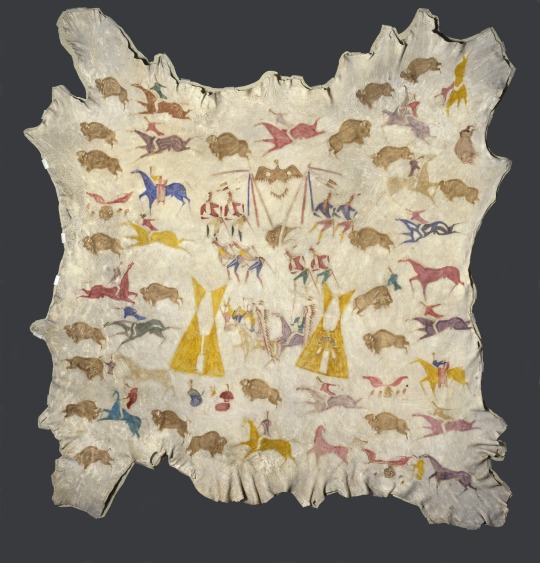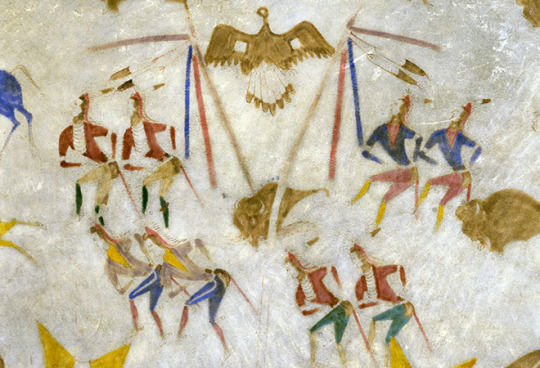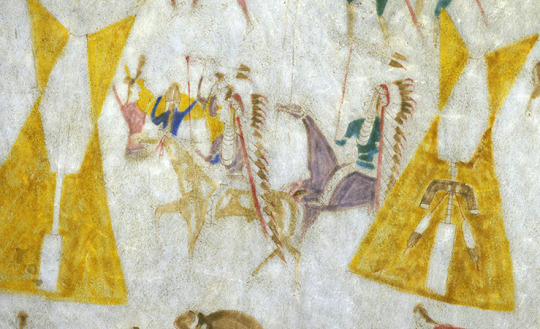#cotsiogo
Photo



Around the year 1900, this elk hide was painted by Cotsiogo (Cadzi Cody) of the Eastern Shoshone people. It harks back to pre-reservation times with scenes of the Wolf and Sun Dances, a buffalo hunt, women butchering buffalo, and warriors on horseback returning to camp.
Prior to the 1860s, when Native people were forced onto reservations by the U.S. government so white settlers could occupy tribal lands, the vast Shoshone territory encompassed what is now southeastern California, central and eastern Nevada, northwestern Utah, southern Idaho, and western Wyoming.
See this hide on the 5th floor as you enter the American Art galleries just beyond the ongoing land acknowledgement statement, which recognizes that the Museum is part of the unceded, ancestral homeland of the Lenape (Delaware) people.
📷 Cotsiogo (Cadzi Cody) (Shoshone, 1866-1912). Painted Elk Hide, ca. 1900. Elk hide, pigment, 81 x 78 in. (205.7 x 198.1 cm). Brooklyn Museum, Dick S. Ramsay Fund, 64.13. Creative Commons-BY (Photo: Brooklyn Museum)
#BkMAmericanArt#Brooklyn Museum#brooklyn#museum#art#indigenous#indigeneous art#indigenous peoples' day#hide#elk hide#cotsiogo#eastern shoshone#shoshone
177 notes
·
View notes
Photo



Attributed to Cotsiogo | Hide Painting of the Sun Dance
c. 1890-1900, Eastern Shoshone (Wind River Reservation, WY), painted elk hide (Indian Arts Research Center, School for Advanced Research, Santa Fe, NM)
1 note
·
View note
Photo

camelid sacrum in the shape of a canine, 14000-7,000 ce, bone, national museum of anthropology, mexico
From Tequixquiac, Mexico
Bone is from camel-like animal
-sacrum bone- Mesoamerican idea that the sacrum is a “second skull”
Forms the skull of a dog/wolf
Found in 1870
The Depiction of Animals:
-Tuffery, Pisupo Lua Afe (corned Beef 200)
-Muyvridge, The Horse in Motion
-Cotsiogo (aka Cadzi Cody), Hide Painting of a Sun Dance
0 notes
Photo

By 1900, when this hide was painted, Cotsiogo’s Eastern Shoshone band was confined to the Wind River Reservation in Wyoming, and the artist turned to the tourist economy as a means of support. This nostalgic work harks back to pre-reservation times with scenes of the Wolf and Sun Dances, a buffalo hunt, women butchering buffalo, and warriors on horseback returning to camp. Prior to the 1860s, when Native people were forced onto reservations by the U.S. government so white settlers could occupy tribal lands, the vast Shoshone territory encompassed what is now southeastern California, central and eastern Nevada, northwestern Utah, southern Idaho, and western Wyoming.
See it in our recently reinstalled spaces American Art galleries that explore the diversity, changing perceptions, and narratives that define this land and its histories.
Cotsiogo (Cadzi Cody) (Shoshone, 1866-1912). Painted Elk Hide Robe, ca. 1900. Elk hide, pigment. Brooklyn Museum, Dick S. Ramsay Fund, 64.13. Creative Commons-BY (Photo: Brooklyn Museum, 64.13_detail_edited_SL1.jpg)
57 notes
·
View notes
Photo

During the nineteenth century, Indigenous people and Euro-American colonists had differing views about land—which influenced the way the environment was represented by the artists of the time. Painters such as the Scottish American William Keith depicted the land in romantic ways, focusing on its majestic and pristine qualities, even though Native people had inhabited and maintained those lands for millennia. Keith's perspective as a settler is contrasted in the gallery with a hide painted by the Shoshone artist Cotsiogo.
Indigenous understandings of the natural world shaped their language, daily life, ceremonies, clothing, and design sensibilities. Their worldview that human beings and the land are interconnected was the opposite of that held by U.S. governmental authorities, who regarded the land as something to be dominated, and removed Indigenous people from ancestral homelands to clear them for white settlers. The legacy of this colonial history continues today.
Installation view of American Galleries, featuring Cotsiogo (Cadzi Cody) (Shoshone, 1866-1912). Painted Elk Hide, ca.1900. Elk hide, pigment. Brooklyn Museum, Dick S. Ramsay Fund, 64.13. Creative Commons-BY [left] and William Keith (American, 1838-1911). Mount Hood, Oregon, ca. 1881-1883. Oil on canvas. Brooklyn Museum, Bequest of Mrs. Charles S. Cooke [right].
#bkmamericanart#indigenous#euro-american#colonist#colonialism#environment#painters#william keith#land#natural world#colonial#settlers
1K notes
·
View notes